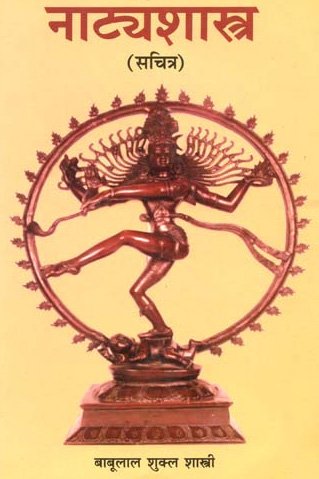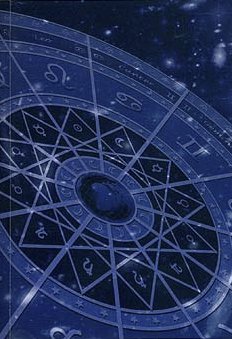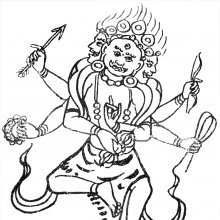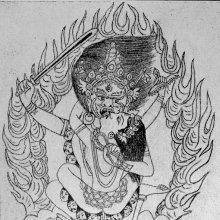Citrakara, Citrakāra, Citra-kara: 16 definitions
Introduction:
Citrakara means something in Hinduism, Sanskrit, the history of ancient India, Marathi. If you want to know the exact meaning, history, etymology or English translation of this term then check out the descriptions on this page. Add your comment or reference to a book if you want to contribute to this summary article.
Alternative spellings of this word include Chitrakara.
Images (photo gallery)
In Hinduism
Natyashastra (theatrics and dramaturgy)
Source: Wisdom Library: Nāṭya-śāstraCitrakāra (चित्रकार, “painter”) refers a member of a theatrical party, according to the Nāṭyaśāstra chapter 35. Accordingly, “one who knows painting is a painter (citrakāra), and from his knowledge of dying (rañjana) a person is called a dyer (rajaka)”.

Natyashastra (नाट्यशास्त्र, nāṭyaśāstra) refers to both the ancient Indian tradition (shastra) of performing arts, (natya—theatrics, drama, dance, music), as well as the name of a Sanskrit work dealing with these subjects. It also teaches the rules for composing Dramatic plays (nataka), construction and performance of Theater, and Poetic works (kavya).
Jyotisha (astronomy and astrology)
Source: Wisdom Library: Brihat Samhita by VarahamihiraCitrakara (चित्रकर) [=Citrakṛt?] refers to “painters”, according to the Bṛhatsaṃhitā (chapter 5), an encyclopedic Sanskrit work written by Varāhamihira mainly focusing on the science of ancient Indian astronomy astronomy (Jyotiṣa).—Accordingly, “If there should be both lunar and solar eclipses in one month, princes will suffer both from dissensions among their own army and from wars. [...] If the eclipses should fall in the lunar month of Caitra painters [i.e., citrakara], writers, singers, prostitutes, men learned in the Vedas and dealers in gold, the people of Pauṇḍra, of Auḍra, of Kekaya and of Āśmaka will suffer distress and there will be good rain throughout the land”.

Jyotisha (ज्योतिष, jyotiṣa or jyotish) refers to ‘astronomy’ or “Vedic astrology” and represents the fifth of the six Vedangas (additional sciences to be studied along with the Vedas). Jyotisha concerns itself with the study and prediction of the movements of celestial bodies, in order to calculate the auspicious time for rituals and ceremonies.
India history and geography
Source: What is India: Epigraphia Indica volume XXXI (1955-56)Citrakara is one of the Brāhmaṇa donees mentioned in the “Asankhali plates of Narasiṃha II” (1302 A.D.). When a grant was made to a large number of Brāhmaṇas, the chief amongst the donees seems to have been called Pānīyagrāhin especially. In the present record, though all the donees (e.g., Citrakara) are referred to as Pāṇigrāhi-mahājana, their list is headed by a Brāhmaṇa with Pāṇigrahī as his surname.
These copper plates (mentioning Citrakara) were discovered from the house of a Santal inhabitant of Pargana Asankhali in the Mayurbhanj State (Orissa). It was made when king Vīra-Narasiṃhadeva was staying at the Bhairavapura-kaṭaka (city, camp or residence).
Source: Cologne Digital Sanskrit Dictionaries: Indian Epigraphical GlossaryCitrakāra.—cf. Cittirakārar (EI 22), a painter. Note: citrakāra is defined in the “Indian epigraphical glossary” as it can be found on ancient inscriptions commonly written in Sanskrit, Prakrit or Dravidian languages.

The history of India traces the identification of countries, villages, towns and other regions of India, as well as mythology, zoology, royal dynasties, rulers, tribes, local festivities and traditions and regional languages. Ancient India enjoyed religious freedom and encourages the path of Dharma, a concept common to Buddhism, Hinduism, and Jainism.
Languages of India and abroad
Marathi-English dictionary
Source: DDSA: The Molesworth Marathi and English Dictionarycitrakāra (चित्रकार).—m (S) A painter, limner, drawer, picture-maker.
Source: DDSA: The Aryabhusan school dictionary, Marathi-Englishcitrakāra (चित्रकार).—m A painter, picture-maker.
Marathi is an Indo-European language having over 70 million native speakers people in (predominantly) Maharashtra India. Marathi, like many other Indo-Aryan languages, evolved from early forms of Prakrit, which itself is a subset of Sanskrit, one of the most ancient languages of the world.
Sanskrit dictionary
Source: DDSA: The practical Sanskrit-English dictionaryCitrakara (चित्रकर).—
1) a painter.
2) an actor.
Citrakara is a Sanskrit compound consisting of the terms citra and kara (कर).
--- OR ---
Citrakāra (चित्रकार).—
1) a painter.
2) Name of a mixed tribe; (sthapaterapi gāndhikyāṃ citrakāro vyajāyata Parāśara).
Derivable forms: citrakāraḥ (चित्रकारः).
Citrakāra is a Sanskrit compound consisting of the terms citra and kāra (कार).
Source: Cologne Digital Sanskrit Dictionaries: Shabda-Sagara Sanskrit-English DictionaryCitrakara (चित्रकर).—m.
(-raḥ) A painter. E. citra colouring, and kara who makes. citraṃ lekhyabhedaṃ āścaryaṃ vā karoti tācchīlyādau ṭa .
--- OR ---
Citrakāra (चित्रकार).—m.
(-raḥ) A painter. E. citra, and kāra who makes. citraṃ karoti kṛ-aṇ-upa-sa0 .
Source: Cologne Digital Sanskrit Dictionaries: Benfey Sanskrit-English DictionaryCitrakāra (चित्रकार).—[citra-kāra], m. A painter, Mahābhārata 5, 5025.
--- OR ---
Citrakara (चित्रकर).—m. a painter, [Kathāsaritsāgara, (ed. Brockhaus.)] 5, 30.
Citrakara is a Sanskrit compound consisting of the terms citra and kara (कर).
Source: Cologne Digital Sanskrit Dictionaries: Cappeller Sanskrit-English DictionaryCitrakara (चित्रकर).—[masculine] painter.
--- OR ---
Citrakāra (चित्रकार).—[masculine] painter.
Source: Cologne Digital Sanskrit Dictionaries: Monier-Williams Sanskrit-English Dictionary1) Citrakara (चित्रकर):—[=citra-kara] [from citra > cit] m. ([Pāṇini 3-2, 21]) a painter (son of an architect by a Śūdra woman, [Brahma-purāṇa i]; or by a gāndhikī, [Parāśara-smṛti] Paddh.), [Varāha-mihira’s Bṛhat-saṃhitā; Kathāsaritsāgara v, 30.]
2) Citrakāra (चित्रकार):—[=citra-kāra] [from citra > cit] m. = -kara, [Mahābhārata v, 5025; Rāmāyaṇa (G) ii, 90, 18; Sāhitya-darpaṇa]
3) [v.s. ...] ‘wonder’, astonishment, [Lalita-vistara xviii, 134.]
Source: Cologne Digital Sanskrit Dictionaries: Yates Sanskrit-English Dictionary1) Citrakara (चित्रकर):—[citra-kara] (raḥ) 1. m. A painter.
2) Citrakāra (चित्रकार):—[citra-kāra] (raḥ) 1. m. Painter.
[Sanskrit to German]
Sanskrit, also spelled संस्कृतम् (saṃskṛtam), is an ancient language of India commonly seen as the grandmother of the Indo-European language family (even English!). Closely allied with Prakrit and Pali, Sanskrit is more exhaustive in both grammar and terms and has the most extensive collection of literature in the world, greatly surpassing its sister-languages Greek and Latin.
Kannada-English dictionary
Source: Alar: Kannada-English corpusCitrakara (ಚಿತ್ರಕರ):—[noun] one who draws or paints pictures.
--- OR ---
Citrakāra (ಚಿತ್ರಕಾರ):—[noun] one who draws or paints pictures.
Kannada is a Dravidian language (as opposed to the Indo-European language family) mainly spoken in the southwestern region of India.
Nepali dictionary
Source: unoes: Nepali-English DictionaryCitrakāra (चित्रकार):—n. 1. an artist; a painter; 2. a Nepalese caste of painters;
Nepali is the primary language of the Nepalese people counting almost 20 million native speakers. The country of Nepal is situated in the Himalaya mountain range to the north of India.
See also (Relevant definitions)
Starts with: Citrakarah, Citrakaraka, Citrakaranyasana.
Ends with: Rudha-citrakara, Ubbucitrakara.
Full-text: Citrakarah, Citragara, Rutes-chitrakaar, Citari, Chitrakaar, Kaar, Cakraphani, Rajaka, Citrakrit, Karna, Hasya, Hasy, Kara, Gandhika, Candaroshana, Kumaridatta, Dharmadhatuvagishvara, Citrikara.
Relevant text
Search found 6 books and stories containing Citrakara, Citrakāra, Citra-kara, Citra-kāra; (plurals include: Citrakaras, Citrakāras, karas, kāras). You can also click to the full overview containing English textual excerpts. Below are direct links for the most relevant articles:
Harshacharita (socio-cultural Study) (by Mrs. Nandita Sarmah)
13. Various Types of Profession < [Chapter 6 - Other Socio-Cultural Aspects]
16.1. Drawing and Painting < [Chapter 6 - Other Socio-Cultural Aspects]
Part 4: Relation Among the Castes < [Chapter 2 - Caste System]
The Indian Buddhist Iconography (by Benoytosh Bhattachacharyya)
Figure 175 - Emanations of Amoghasiddhi: Vajraśṛṅkhalā
The Nilamata Purana (by Dr. Ved Kumari)
The Agni Purana (by N. Gangadharan)
Maha Prajnaparamita Sastra (by Gelongma Karma Migme Chödrön)
Part 4 - Story of the complete gift of the painter Karṇa < [Chapter XIX - The Characteristics of Generosity]
Natyashastra (English) (by Bharata-muni)

